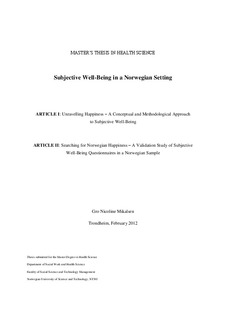| dc.contributor.advisor | Espnes, Geir Arild | nb_NO |
| dc.contributor.author | Mikalsen, Gro Nicoline | nb_NO |
| dc.date.accessioned | 2014-12-19T14:34:08Z | |
| dc.date.available | 2014-12-19T14:34:08Z | |
| dc.date.created | 2012-07-31 | nb_NO |
| dc.date.issued | 2012 | nb_NO |
| dc.identifier | 542338 | nb_NO |
| dc.identifier.uri | http://hdl.handle.net/11250/267862 | |
| dc.description.abstract | Abstract artikkel 1
Subjective well-being (SWB) is an upcoming concept that has caught the attention of the scientific community and society in general. Although much has been learned about the nature of “happiness” both the definition and measurements are still a work in progress. The current paper aimed to examine how global subjective well-being best can be measured based in the current theoretical understanding of the definition and assessment methods. SWB is by Diener (2009) considered to have three main components: positive affect, negative affect and life satisfaction. The concept is complex with many interconnecting dimensions and correlates. The choice of SWB measurement method or instrument should be based on an understanding of the nature of SWB in addition to the study’s design and purpose. Self-report measures are the most utilized and generally shows good psychometric properties. This paper primarily recommends using the Satisfaction With Life Scale (SWLS; Diener, Emmons, Larsen & Griffin 1985) combined with Scale of Positive And Negative Experience (SPANE; Diener et al. 2009) to measure SWB.
Abstract artikkel 2
The interest and knowledge of subjective well-being (SWB) and its applicability has the latest decades grown both socially and scientifically. Assessment instruments validated for different languages and cultures can assist in the further development of the SWB concept as well as provide a base for monitoring communities’ fluctuations in SWB levels and operate as a social indicator index. Objective: The following study aimed at translating and validating four acknowledged SWB instruments on a Norwegian sample. Participants: Self-completion questionnaires were administered to convenience samples of senior citizens and university students in Trondheim, Norway. n = 254, 154 females, age 19-96. Design: Psychometric properties such as internal consistency, normative data, factorial structure and convergence validity were examined using independent sample t-tests and principal component factor analyses. Results and conclusions: The findings were overall consistent with previous findings. Overall no major divergences from the scales established psychometric standards were found which suggests that the questionnaires are fit for use on Norwegian samples. Furthermore, the study supports the scales as having good psychometric properties.
| nb_NO |
| dc.language | eng | nb_NO |
| dc.publisher | Norges teknisk-naturvitenskapelige universitet, Fakultet for samfunnsvitenskap og teknologiledelse, Institutt for sosialt arbeid og helsevitenskap | nb_NO |
| dc.subject | Subjective well-being | en_GB |
| dc.subject | Happiness | en_GB |
| dc.subject | Assessment | en_GB |
| dc.subject | Social and Behavioural Science, Law | en_GB |
| dc.title | Subjective Well-Being in a Norwegian Setting | nb_NO |
| dc.type | Master thesis | nb_NO |
| dc.source.pagenumber | 74 | nb_NO |
| dc.contributor.department | Norges teknisk-naturvitenskapelige universitet, Fakultet for samfunnsvitenskap og teknologiledelse, Institutt for sosialt arbeid og helsevitenskap | nb_NO |
